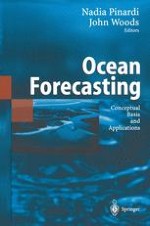2002 | OriginalPaper | Buchkapitel
A Generalization of a Sigma Coordinate Ocean Model and an Intercomparison of Model Vertical Grids
verfasst von : George L. Mellor, Sirpa M. Häkkinen, Tal Ezer, Richard C. Patchen
Erschienen in: Ocean Forecasting
Verlag: Springer Berlin Heidelberg
Enthalten in: Professional Book Archive
Aktivieren Sie unsere intelligente Suche, um passende Fachinhalte oder Patente zu finden.
Wählen Sie Textabschnitte aus um mit Künstlicher Intelligenz passenden Patente zu finden. powered by
Markieren Sie Textabschnitte, um KI-gestützt weitere passende Inhalte zu finden. powered by
Numerical ocean models increasingly make use of σ — coordinate systems. A paper by Gerdes (1993) shows that these coordinate systems can be more general; he termed the generalized form an “s — coordinate” system. The main advantage of the σ or s — system is that, when cast in a finite difference form, a smooth representation of the bottom topography is obtained; one can also easily incorporate a bottom boundary layer as well as a surface boundary layer in those coordinate systems. This is intuitively appealing and Gerdes has shown that superior numerical results are obtained relative to a z — level system. However, in regions of steep topography and crude resolution — a limiting case would be a seamount represented by a single grid point surrounded by a flat bottom — the so-called sigma coordinate pressure gradient error exists (Haney 1991, Mellor et al. 1994, 1998) and at least locally a z — level coordinate system might be preferred. On the other hand, in a recent study, Bell (1997) has shown that the step structure of z — level models lead to vorticity errors and consequent errors in the barotropic component of the flow which, he reports, cause rather large temperature errors (3 to 4° C) on a 1° x 1° grid of an Atlantic Ocean model after 3 months of integration. And it is difficult to model bottom boundary layers in a z — level model (Winton et al. 1998).
